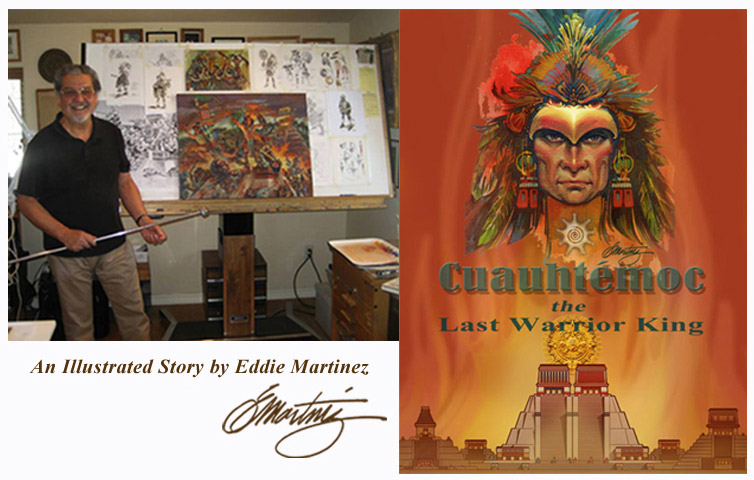Part 3 March 2015, Sevilla, Spain and Pensacola
By Eddie Martinez, Somos Primos article
ART, HISTORY & CULTURE:
Walking the streets of Spain while sketching and listening for voices from the past
Bv Eddie Martinez, edited and translated in Spanish by Viola Rodriguez Sadler

ARTE, HISTORIA & CULTURA:
Caminando por las calles de Espaha dibujando y escuchando las voces del pasado
Por Eddie Martinez, editado y traducido al espanol por Viola Rodriguez Sadler
Sevilla has many magnificent historical Spanish/Moorish buildings, if only they could speak. This is a sketch I made in an attempt to capture this particular ornate building with two arched columns towers in the plaza of Cervecería Puerto Plata.

Sevilla tiene muchos y magníficos e históricos edificios españoles/moriscos, si siquiera pudieran hablar. Este es un dibujo que hice en un intento de capturar este particular edificio adornado con dos torres con columnas de arcos en la plaza de la Cervecería Puerto Plata.
The photograph below left is the Cathedral looking through the Moorish arch of the Puerta del Perdón. Below right is the City Hall, in the Plaza de San Francisco. I regard the City Hall as a fine example of the Renaissance Spanish architecture and ornament during the 1500’s.
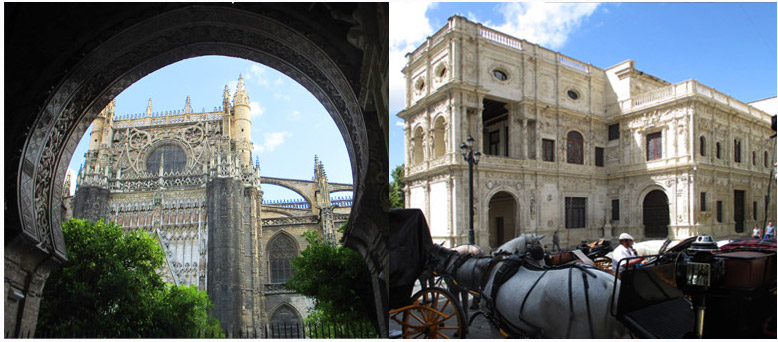 La fotografía arriba a la izquierda es la Catedral viendo a través de los arcos moriscos de la Puerta del Perdón. Arriba a la derecha se encuentra el Ayuntamiento, en la Plaza de San Francisco. Considero al Ayuntamiento de la ciudad como un buen ejemplo de la arquitectura renacentista española y ornamento durante el siglo XV.
La fotografía arriba a la izquierda es la Catedral viendo a través de los arcos moriscos de la Puerta del Perdón. Arriba a la derecha se encuentra el Ayuntamiento, en la Plaza de San Francisco. Considero al Ayuntamiento de la ciudad como un buen ejemplo de la arquitectura renacentista española y ornamento durante el siglo XV.
These are two photographs of the exteriors and interior of Sevilla’s Royal Palace, the Real Alcázar that was built in 913 as a fortified Moorish palace by Abdeerramán III of Córdoba. If I remember correctly, our tour guide told us that Queen Isabella remodeled the Real Alcázar as her own royal court, where she made important decisions on the Spanish sea voyages to the West Indies. In 1540 Charles V added the upper story patio of the Alcázar that was completed in 1572. Another interesting bit of information is that Hollywood filmed scenes for “Lawrence of Arabia” in the Real Alcázar.

Estas son dos fotografías de las fachadas y el interior del Palacio Real de Sevilla, el Real Alcázar fue construido en el año 913 como un palacio morisco por Abdeerramán III de Córdoba. Si no recuerdo mal, nuestro guía nos dijo que la Reina Isabel remodeló el Real Alcázar para su propia corte real, donde realizaron decisiones importantes sobre los viajes españoles marítimos hacia las Indias Occidentales. En 1540 Carlos V añadió el patio en la parte superior del Alcázar que se completó en 1572. Otro interesante pormenor es que Hollywood filmó escenas de Lawrence de Arabia en el Real Alcázar.
This is a detailed section of an artist’s depiction of the Torre del Oro or Tower of Gold that was originally built by the Moors in 1220. The Spanish turret was added on the top in 1760. This beautiful Torre del Oro is now Sevilla’s Museo Maritimo, a Maritime Museum.
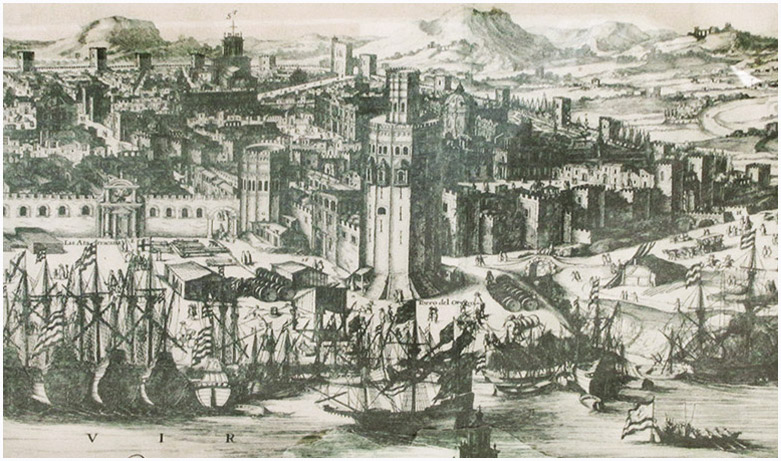 Esta es una sección detallada de la representación de un artista de la Torre del Oro que originalmente fue construida por los moros en 1220. La torreta española se añadió en la parte superior en 1760. Esta hermosa Torre del Oro es ahora Museo Marítimo de Sevilla.
Esta es una sección detallada de la representación de un artista de la Torre del Oro que originalmente fue construida por los moros en 1220. La torreta española se añadió en la parte superior en 1760. Esta hermosa Torre del Oro es ahora Museo Marítimo de Sevilla.
This is a picture of my wife Jessie on the river walkway that leads to the Torre del Oro in the background. Next to her is my sketch of the Moorish Tower of Gold with the turret on top.
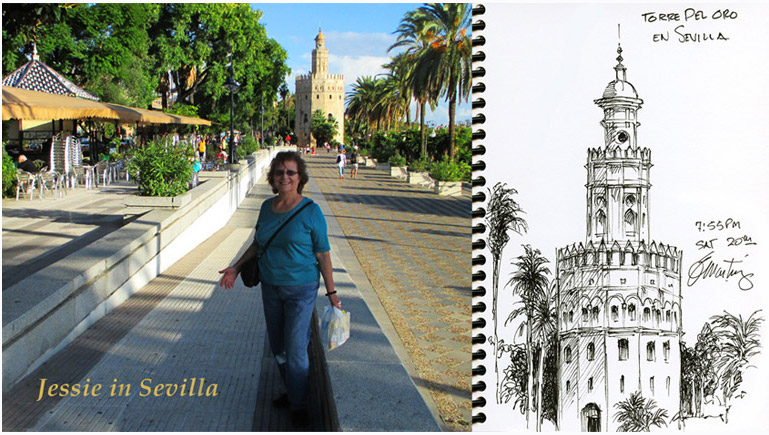 Esta es una fotografía de mi esposa Jessie en el pasaje peatonal del río que conduce a la Torre del Oro en el fondo. Al lado de ella esta mi esbozo de la Torre de Oro con la torrecilla arriba.
Esta es una fotografía de mi esposa Jessie en el pasaje peatonal del río que conduce a la Torre del Oro en el fondo. Al lado de ella esta mi esbozo de la Torre de Oro con la torrecilla arriba.
The following two photographs were taken from the top of the Tower of Gold looking in both directions of the grand Río Guadalquivir. The picture on the left shows the river going to the south, to the seaport city of Jerez de la Frontera. The picture on the right shows the river coming from the north, from the then Moorish capital city of Córdoba. While looking at the wide broad river, my creative mind is filled with colorful images of splendid Moorish ships passing by the thriving merchant city of Sevilla after leaving the Caliph’s city of Córdoba heading to the Pacific Ocean to Cádiz, this was Iberia’s gateway to the far east all the way to Kubla Khan’s Cathay, the capital city of China… as I viewed the flowing Río Guadalquivir my mind was filled with images of yet another wonderful Andalusia story filled with drawings and paintings.
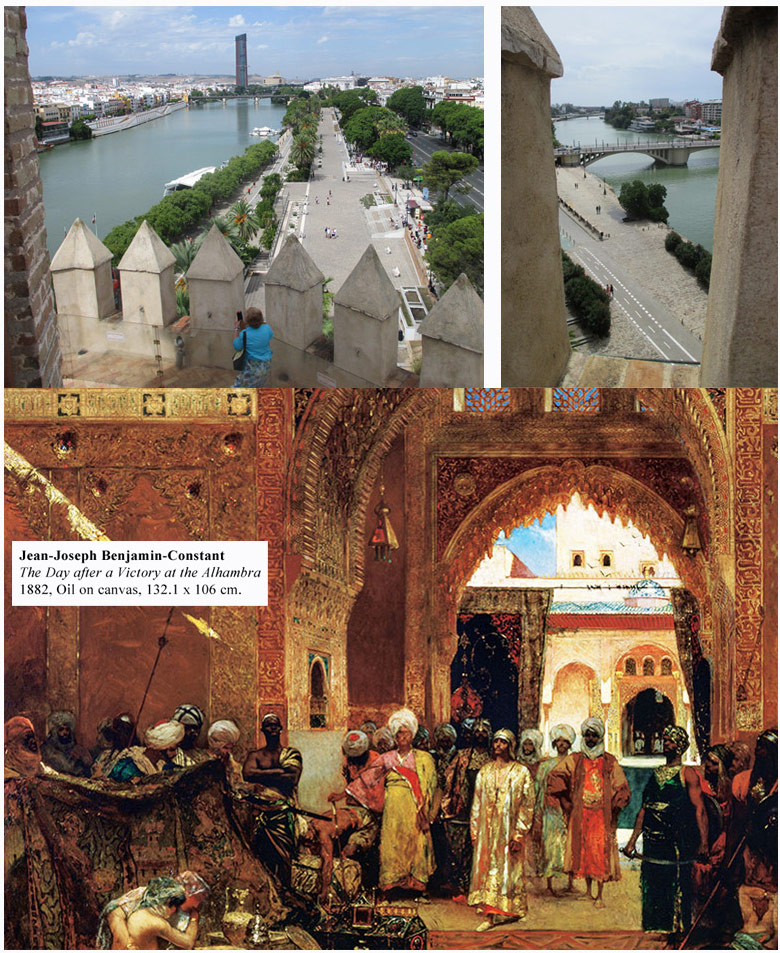
Las dos fotografías de arriba fueron tomadas desde la cumbre de la Torre de Oro de donde se mira en ambas direcciones el magnífico Río Guadalquivir. En la fotografía a la izquierda se ve el río que va al sur, a la ciudad de puerto de Jerez de la Frontera. A la derecha se muestra el río viniendo del norte, de Córdoba, la antigua capital Mora. Mirando el amplio río, mi mente creativa se llena de imágenes vistosas de barcos Moros espléndidos que pasan por la ciudad mercante próspera de Sevilla después de dejar la ciudad del Califa de Córdoba, que dirigiéndose al Océano Pacífico a Cádiz, esta era la entrada de Iberia al oriente lejano en todo a Catay de Kubla Khan, la capital de China … cuando vi la corriente del Río Guadalquivir mi mente se llenó de imágenes de aún otra maravillosa historia de Andalucía.
Inside the Maritime Museum I took many photographs of the exhibits and displays of maritime maps, ships paintings, ship models, portraits and paintings of naval officers, and many other naval antiquities. The map on the lower left is a Spanish cartography map indicating the Spanish ports of interest in the Mediterranean and the Atlantic Ocean that leads westerly to the Spain’s West Indies. On the lower right a beautifully detailed etchings of the robust port city of Sevilla, both of these, I believe are circa 16th century.

Adentro del Museo Marítimo tomé muchas fotografías de la exposición y muestra de mapas marítimos, pinturas de buques, maquetas de barcos, retratos y pinturas de los oficiales de marina, y muchas otras antigüedades navales. El mapa de la parte superior izquierda es una cartografía Española indicando los puertos españoles de interés en el Mediterráneo y el Océano Atlántico que conducen hacia el oeste a las Indias Occidentales de España. En la parte superior derecha un gran detalle aguafuertes de la robusta ciudad portuaria de Sevilla, ambas creo que son circa siglo XVI.
These two are photographs of ships are of special interest to me because I enjoy studying the architectural framing and antiquity of different ships. The painting in lower left is a fleet of ships at sea with colorful Spanish heraldry on their masts. In the lower right is a scaled model of a three-masted merchant carrack. Both I believe are circa 15th century.

Estas dos fotografías de los buques son de interés especial para mí, porque me gusta estudiar la estructura arquitectónica y la antigüedad de diferente buques. La pintura en la parte superior izquierda es una flota de buques en alta mar, con colorida heráldica Española con sus palos. En la parte superior derecha es un modelo de escala de un carraca mercantil de tres mástiles. Creo que ambas son de circa siglo XV.
Below are two ship paintings that I most admired because of their tall and elegant grandeur. The lower left painting I believe would be dated circa 16th or 17th century; the King’s Sovereign’s of the Sea and the Manila Galleons or Treasure Ships as they were called because they were the ones that sailed from Miguel Lopez de Legazpi’s Philippines Islands across the Pacific Ocean east to Acapulco bay bringing with them Asia’s most prized treasures to add to the wealth of New Spain. The lower right is a painting of the 18th century Ship’s of the Line or men-of-war with deck guns that the Spanish navy used to protect the territories in the Gulf of Mexico and the Caribbean against England’s naval force in Jamaica, Belize and the disputed territory for Honduras because of its natural resources.

Arriba son dos pinturas de barcos que yo más admiro debido a su grandeza alta y elegancia. La pintura izquierda superior creo que sería datada hacia al siglo XVI o el XVII; el Soberano del Rey del Mar y los Galeones de Manila o Barcos de Tesoro como los llamaron porque estos eran navegado de Miguel López de las Islas de Filipinas de Legazpi a través de Océano Pacífico al este hacia la bahía Acapulco trayendo con ellos los tesoros más estimados de Asia para añadir a la riqueza de Nueva España. A la derecha superior esta una pintura del Barco de la Línea del siglo XVIII, o hombres de guerra con armas de cubierta que la marina española solía proteger los territorios en el Golfo de México y el Caribe contra la fuerza naval de Inglaterra en Jamaica, Belice y el territorio disputado para Honduras debido a sus recursos naturales.
When I saw the Spanish naval officers uniforms my mind was drawn to Spain and the American Revolutionary War. I was amazed to see these beautiful detailed color renderings of Spanish uniforms: Below left are two naval Captains, first 1745 and second 1775. Below right, are two Captain Generals, 1784 and 1894.

Cuando vi los uniformes de oficiales navales españoles mi mente fue a España y la Guerra Revolucionaria americana. Me asombró ver estas interpretaciones en color detalladas hermosas de uniformes españoles: Arriba izquierda son dos Capitanes navales, el primero 1745 y el segundo 1775. Arriba a derecha, son dos Generales de Capitán, 1784 y 1894.
Inspired after seeing the ships and uniforms I began thinking more about Spain and our American Heritage: I was reminded once again of Spain’s 2010 exhibition and lectures in Santa Fe, New Mexico, and how I my interest was mostly on Spanish General Bernardo de Gálvez and his many military campaigns against Great Britain and the many battle’s that were fought on the Mississippi River and coastal fortifications in the Gulf of Mexico.

Inspirado después de ver los barcos y uniformes comencé a pensar más en España y nuestra Herencia Americana: me recordaron otra vez de la exposición de España de 2010 y lecturas en Santa Fe, Nuevo México, y como sobre todo mi interés era el General español Bernardo de Gálvez y sus muchas campañas militares contra Gran Bretaña y tantas batallas que lucharon en el Río Misisipi y fortalecimientos costeros en el Golfo de México.
My appreciation of Bernardo de Gálvez began when Mimi Lozano asked me to develop a presentation on Hispanics in the Military that was sponsored by Somos Primos' 2005 Hispanic Heritage Activities and the National Archives and Records Administration in Washington D.C. My presentation to the National Archives was titled Hispanics in America’s Defense: Latino Blood, American Hearts. The first segment was Spain and the American Revolution. Since then I have read Tomas E. Chávez’s book, Spain and the Independence of the United States: An Intrinsic Gift. Below are the drawings of Bernardo de Gálvez’s flagship, the Galveztown, and a portrait of de Gálvez that I painted for the PowerPoint presentation in Washington D.C.

Mi apreciación de Bernardo de Gálvez comenzó cuando Mimi Lozano me pidió desarrollar una presentación en Hispanos Militares, que fue patrocinado por Somos Primos—Actividades de Herencia Hispana del 2005 y los Archivos Nacionales y Administración de Archivos en Washington D.C. Mi presentación a los Archivos Nacionales se tituló Hispanos en la Defensa de América: Sangre de Latino, Corazones Americanos. El primer segmento era España y la Revolución Americana. Posteriormente leí el libro de Tomas E. Chávez, España y la Independencia de los Estados Unidos: un Regalo Intrínseco. Arriba estan los dibujos del buque insignia de Bernardo de Gálvez, el Galveztown, y un retrato de Gálvez que pinté para la presentación PowerPoint en Washington D.C.
After having shared my drawings with historian Tom Chávez, we discussed the many events that lead up to the battle of Pensacola Bay. These are some of my drawings on that climatic battle: On March 9, 1781, General Bernardo de Gálvez landed his troops on Santa Rosa Island. The two drawings below, on the left is Bernardo de Gálvez’s flagship, the Galveztown as it enters Pensacola Bay. On the right is the brigantine Galveztown leading two gunboats the Riaño a sloop and the Valenzuela into the bay, because of the success of this decisive military action; Bernardo de Gálvez was awarded the king’s royal title of, Yo Solo or “I Alone.”

Después de haber compartido mis dibujos con el historiador Tomás Chávez, hemos hablado de los muchos acontecimientos que conducen hasta la batalla de Pensacola Bay. Estos son algunos de mis dibujos sobre las batalla: El 9 de marzo, 1781, el General Bernardo de Gálvez desembarcó sus tropas en la Isla Santa Rosa. Los dos dibujos en la parte superior, izquierda esta el buque insignia de Bernardo de Gálvez, el Galveztown en el momento en que entra en Pensacola Bay. A la derecha está el bergantín Galveztown liderando dos cañoneras el Riaño un sloop y la Valenzuela en la bahía; debido al éxito de esta acción militar decisiva, a Bernardo de Gálvez se le adjudicó el título real del rey, Yo Solo.
The drawing below left shows the flagship Galveztown under canon fire from Fort Barranca as commander Bernardo de Gálvez commands the crew onboard the brigantine to return fire as he battles his way into the bay of Pensacola. The drawing on the lower right is of Bernardo de Gálvez and his officers planning the final attack on Fort George. Left to right: The King’s emissary, Francisco Saavedra; the field marshal and commander Bernardo de Gálvez; the brigadier general Jerónimo Girón y Moctezuma; and the major general José de Ezpeleta. On May 10, 1781 General Campbell surrendered Pensacola to General Bernardo de Gálvez. England’s defeat in Pensacola was the conclusion of Bernardo de Gálvez’s victories against the British in the Mississippi River and the English ports in the Gulf of Mexico; It was truly Spain’s “Intrinsic Gift” to the United States as written by Thomas E. Chávez in his account, Spain and the Independence of the United States: An Intrinsic Gift.

El dibujo de arriba a la izquierda muestra el buque Galveztown bajo fuego de canon de Fort Barranca cuando el comandante Bernardo de Gálvez ordena a la tripulación del bergantín devolver el fuego en su camino hacia la bahía de Pensacola. El dibujo en la parte superior derecha es de Bernardo de Gálvez y sus funcionarios encargados de planificar el asalto final contra Fort George. Izquierda a derecha: el emisario del Rey, Francisco Saavedra; el mariscal de campo y el comandante Bernardo de Gálvez, el general de brigada Jerónimo Girón y Moctezuma, y el general de división José de Ezpeleta. El 10 de mayo de 1781 General Campbell rindió Pensacola al General Bernardo de Gálvez. La derrota de Inglaterra en Pensacola fue la conclusión de las victorias de Bernardo de Gálvez contra los británicos en el Río Misisipi y a los puertos ingleses en el Golfo de México; fue verdaderamente de España “Un Regalo Intrínseco” a los Estados Unidos, como escribió Thomas E. Chávez en su relato, España y la Independencia de los Estados Unidos: Un Regalo Intrínseco.
As we made our way back to our hotel we stopped to appreciate the beautiful white EME Hotel. I liked the name because it was also the name of our family company, EME Entertainment Design. From the hotel I turned around to see the most beautiful sight of the cathedral tower as the sun was setting and the up-lights of the cathedral began illuminating the magnificent Moorish Gothic tower, a sight that will remain with me forever as a reminder of our stay in the historic city of Sevilla.

Cuando íbamos de regreso a nuestro hotel nos detuvimos para apreciar el hermoso blanco Hotel EME. Me gustó el nombre porque era el nombre de nuestra empresa familiar, EME Diseño para el Entretenimiento. Desde el hotel me di la vuelta para ver la más hermosa vista de la torre de la catedral cuando el sol se ponía y las luces de la catedral empezaron a iluminar la magnífica torre gótica Morisca, una vista que permanecerá conmigo para siempre, como un recuerdo de nuestra estancia en la histórica ciudad de Sevilla.
In my next April article, I will be describing my visits to the historical port city of Jerez de la Frontera, along with photographs and sketches that continue to feed my passion and quest to find the answers on the why’s and how’s of the Spanish expeditions and the encounters that were made in the Americas.
En mi próximo artículo para Abril, voy a describir mis visitas a la histórica ciudad portuaria de Jerez de la Frontera, junto con fotografías y esquemas que continúan alimentando a mi pasión y la búsqueda para encontrar las respuestas al porque y como acerca de las expediciones españolas y los encuentros que se realizaron en las Américas.
Cuauhtémoc, the Last Warrior King
